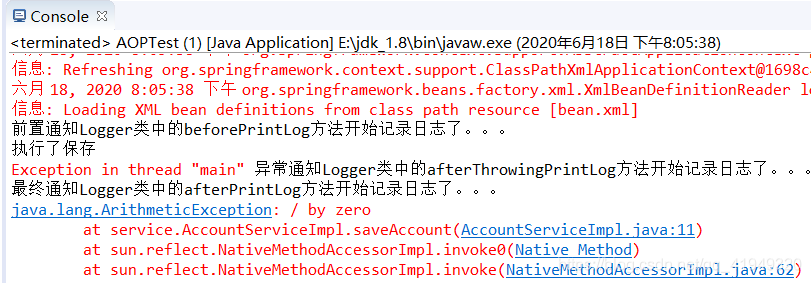SpringAOP的四种通知类型:前置通知、异常通知、后置通知、异常通知
给出 账户的业务层接口 IAccountService.java,
为了便于演示这四种通知类型,我们就只留下了一个方法。
public interface IAccountService {
void saveAccount();
}
给出 账户的业务层接口的实现类 AccountServiceImpl.java
public class AccountServiceImpl implements IAccountService{
@Override
public void saveAccount() {
System.out.println("执行了保存");
//int i=1/0;
}
}
给出一个日志类, 用于打印日志
public class Logger {
/**
* 前置通知
*/
public void beforePrintLog(){
System.out.println("前置通知Logger类中的beforePrintLog方法开始记录日志了。。。");
}
/**
* 后置通知
*/
public void afterReturningPrintLog(){
System.out.println("后置通知Logger类中的afterReturningPrintLog方法开始记录日志了。。。");
}
/**
* 异常通知
*/
public void afterThrowingPrintLog(){
System.out.println("异常通知Logger类中的afterThrowingPrintLog方法开始记录日志了。。。");
}
/**
* 最终通知
*/
public void afterPrintLog(){
System.out.println("最终通知Logger类中的afterPrintLog方法开始记录日志了。。。");
}
}
给出配置信息bean.xml
<?xml version="1.0" encoding="UTF-8"?>
<beans xmlns="http://www.springframework.org/schema/beans"
xmlns:xsi="http://www.w3.org/2001/XMLSchema-instance"
xmlns:aop="http://www.springframework.org/schema/aop"
xsi:schemaLocation="http://www.springframework.org/schema/beans
http://www.springframework.org/schema/beans/spring-beans.xsd
http://www.springframework.org/schema/aop
http://www.springframework.org/schema/aop/spring-aop.xsd">
<!-- 配置srping的Ioc,把service对象配置进来-->
<bean id="accountService" class="service.AccountServiceImpl"></bean>
<!-- 配置Logger类 -->
<bean id="logger" class="utils.Logger"></bean>
<!--配置AOP-->
<aop:config>
<!--配置切入点表达式 -->
<aop:pointcut id="pt1" expression="execution(* service.AccountServiceImpl.saveAccount())"></aop:pointcut>
<!--配置切面 -->
<aop:aspect id="logAdvice" ref="logger">
<!-- 配置前置通知:在切入点方法执行之前执行-->
<aop:before method="beforePrintLog" pointcut-ref="pt1" ></aop:before>
<!-- 配置后置通知:在切入点方法正常执行之后值-->
<aop:after-returning method="afterReturningPrintLog" pointcut-ref="pt1"></aop:after-returning>
<!-- 配置异常通知:在切入点方法执行产生异常之后执行-->
<aop:after-throwing method="afterThrowingPrintLog" pointcut-ref="pt1"></aop:after-throwing>
<!-- 配置最终通知:无论切入点方法是否正常执行它都会在其后面执行-->
<aop:after method="afterPrintLog" pointcut-ref="pt1"></aop:after>
</aop:aspect>
</aop:config>
</beans>
1)异常通知和后置通知永远只能执行一个
2)配置切入点表达式
此标签写在aop:aspect标签内部只能当前切面使用。
它还可以写在aop:aspect外面,此时就变成了所有切面可用
给出Test类
public class AOPTest {
public static void main(String[] args) {
//1.获取容器
ApplicationContext ac = new ClassPathXmlApplicationContext("bean.xml");
//2.获取对象
IAccountService as = (IAccountService)ac.getBean("accountService");
//3.执行方法
as.saveAccount();
}
}
执行结果:

当我们放开AccountServiceImpl类中我们故意制造的异常 int i=1/0;时:

环绕通知,只需要稍稍微改变上面例子的两点即可
public class Logger {
public Object aroundPringLog(ProceedingJoinPoint pjp){
Object rtValue = null;
try{
Object[] args = pjp.getArgs();//得到方法执行所需的参数
System.out.println("Logger类中的aroundPringLog方法开始记录日志了。。。前置");
rtValue = pjp.proceed(args);//明确调用业务层方法(切入点方法)
System.out.println("Logger类中的aroundPringLog方法开始记录日志了。。。后置");
return rtValue;
}catch (Throwable t){
System.out.println("Logger类中的aroundPringLog方法开始记录日志了。。。异常");
throw new RuntimeException(t);
}finally {
System.out.println("Logger类中的aroundPringLog方法开始记录日志了。。。最终");
}
}
}
注意:pjp.proceed(args)会报异常,必须用 Throwable t,因为Exception拦不住它
<?xml version="1.0" encoding="UTF-8"?>
<beans xmlns="http://www.springframework.org/schema/beans"
xmlns:xsi="http://www.w3.org/2001/XMLSchema-instance"
xmlns:aop="http://www.springframework.org/schema/aop"
xsi:schemaLocation="http://www.springframework.org/schema/beans
http://www.springframework.org/schema/beans/spring-beans.xsd
http://www.springframework.org/schema/aop
http://www.springframework.org/schema/aop/spring-aop.xsd">
<!-- 配置srping的Ioc,把service对象配置进来-->
<bean id="accountService" class="service.AccountServiceImpl"></bean>
<!-- 配置Logger类 -->
<bean id="logger" class="utils.Logger"></bean>
<!--配置AOP-->
<aop:config>
<!--配置切入点表达式 -->
<aop:pointcut id="pt1" expression="execution(* service.AccountServiceImpl.saveAccount())"></aop:pointcut>
<!--配置切面 -->
<aop:aspect id="logAdvice" ref="logger">
<!-- 配置环绕通知 详细的注释请看Logger类中-->
<aop:around method="aroundPringLog" pointcut-ref="pt1"></aop:around>
</aop:aspect>
</aop:config>
</beans>
我们都知道,AOP机制的核心是在不修改源码的基础上对业务层方法的增强。
public AccountService getAccountService() {
return (AccountService) Proxy.newProxyInstance(accountService.getClass().getClassLoader(), accountService.getClass().getInterfaces(), new InvocationHandler() {
@Override
public Object invoke(Object o, Method method, Object[] objects) throws Throwable {
Object rtValue=null;
try {
//1、开启事务
txManager.beginTransaction();
//2、执行操作,整个过程像对每个方法进行了包装,并返回新的accountService对象
rtValue=method.invoke(accountService,objects);
//3、提交事务
txManager.commit();
//4、返回结果
return rtValue;
}catch (Exception e){
//5、回滚事务
txManager.rollback();
throw new RuntimeException(e);
}finally {
//6、释放连接
txManager.release();
}
}
});
}
如果不明确调用业务层方法,就像一个画皮,没有发挥本质的作用。
除此之外,我认为环绕通知可以代替其他的四个通知,
public Object aroundPrintLog(ProceedingJoinPoint pjp){//环绕通知是不是能够代替其他的通知
Object rtvalue=null;
try {
/**
*这里的一切都是为都是给业务层方法进行增强,例如:把那些方法拿过来,然后核心的还是rtvalue=pjp.proceed(args),
*其他的输出只不过是为核心的业务层方法进行修饰
*/
Object[] args=pjp.getArgs();//得到方法执行所需的参数
System.out.println("前置通知");
rtvalue=pjp.proceed(args);//明确调用业务层方法
System.out.println("后置通知");
return rtvalue;
}catch (Throwable e){
System.out.println("异常通知");
throw new RuntimeException(e);
}finally {
System.out.println("最终通知");
}
}
这个属于典型的环绕通知,其中把输出方法换成相应的通知方法就可以(有不同观点的可以说出来一起讨论)。
最后,分享一下我学这个知识的方法。方法增强,本质上就是对源码不修改的情况下进行方法的加工。就好像烤羊肉串一样,其中的核心就是羊肉,就像公司给你的业务层方法(这个是不让修改的)。在给顾客使用前,收先对羊肉进行刷油、烤、撒料一系列过程,这一过程就是我们对业务层方法的增强,使业务层的功能更加健壮,对应的烧烤也就是更美味。核心的一点就是正确调用业务层的方法,不管在哪类通知中,都能对业务层方法进行正确、有效地增强
以上为个人经验,希望能给大家一个参考,也希望大家多多支持。